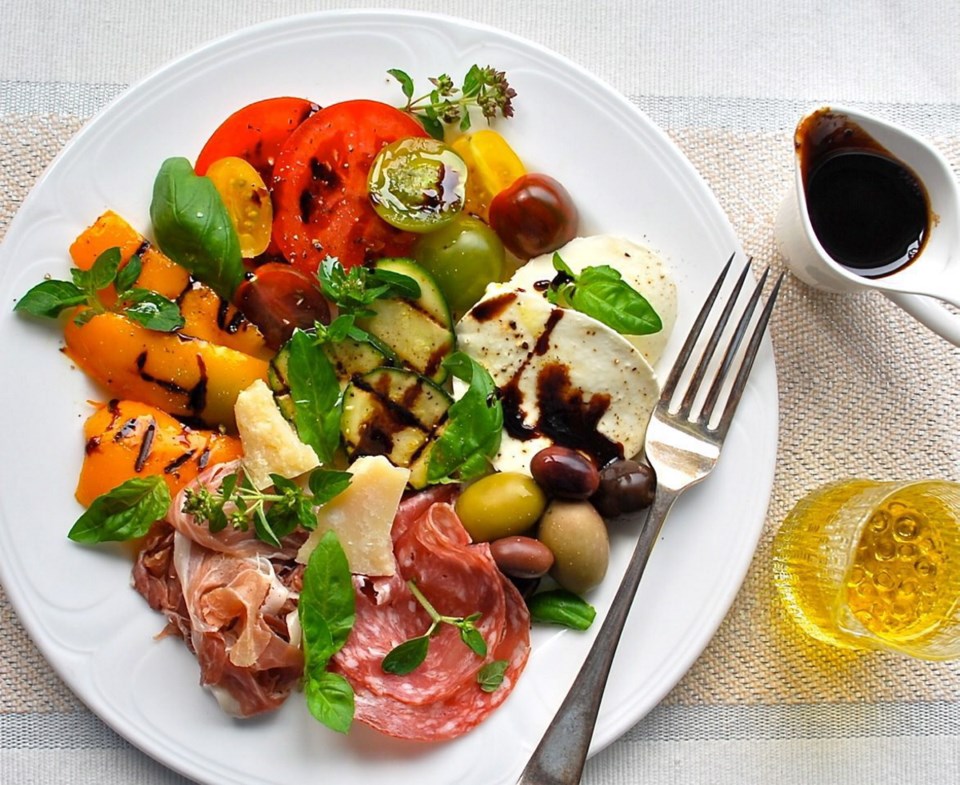You’re having friends over for a summer lunch and want to serve something that’s not too fussy to prepare, but is still very flavourful and eye appealing. Can’t decide what to make?
I have a solution.
Combine local, summer produce with cured meats, cheese and olives to create a kind of Italian-style ploughman’s lunch. Rather than using English-style meats and cheese, you use Italian-style ones.
That’s what I did for today’s recipe. When shopping for ingredients, I realized I was choosing the same sorts of things I might include when making a platter of antipasto designed to serve a crowd.
In this case, though, I wanted to create individual servings that would act as the main dish, not as an appetizer — which is how a selection of antipasto, a term that means “before the meal,” is usually served. That’s why I decided to my call recipe antipasto lunch plates.
Ripe and wonderful tomatoes, grilled zucchini and bell peppers, fresh mozzarella and Parmesan cheese, prosciutto and salami, and olives are artfully presented on dinner plates.
They don’t need a lot of fancy seasonings or toppings to enhance their flavour. So I kept things simple, sprinkling a bit of sea salt and freshly ground black pepper on the vegetables and cheese, and scattering fresh basil leaves and small sprigs of fresh oregano on and around everything on the plate.
Once the antipasto lunch plates are served, diners can further enhance their flavour by drizzling them with a bit of extra virgin olive oil and balsamic crema, a reduced style of balsamic vinegar.
Serve the lunch plates with some good bread and, if you like, wine, perhaps prosecco, pinot grigio or rosé.
Antipasto Lunch Plates
In this cool and colourful Italian-style summer meal, items you might put on a platter of antipasto are served on individual plates.
Preparation time: 30 minutes
Cooking time: about four minutes
Makes: four servings
1 medium orange bell pepper, halved, seeds removed, flesh cut into 12 wedges
1 small to medium zucchini, cut into 1/2-inch slices
• extra virgin olive oil, to taste
• flaked sea salt and freshly ground black pepper, to taste
1 medium ripe red tomato, cut into 8 slices
12 mixed coloured cherry tomatoes, each halved
1 (250-gram) tub fresh mozzarella cheese, drained well and cut into 8 slices (see Note)
100-gram chunk Parmesan cheese, broken into 8 thumb-sized pieces
8 paper-thin slices prosciutto
12 paper-thin slices salami
20 to 24 assorted types of olives
• small fresh basil leaves and small sprigs of fresh oregano (see Eric’s options), to taste
• balsamic crema, to taste (see Note)
Preheat your barbecue or indoor grill to medium-high (see Eric’s options). Place bell pepper and zucchini in a shallow bowl, drizzle lightly with olive oil, season with salt and pepper, and turn to coat.
Grill the bell pepper and zucchini until just tender and lightly charred, about two minutes per side. Set these grilled vegetables back in the shallow bowl and cool to room temperature.
Set out four dinner plates. Divide and artfully arrange the grilled peppers and zucchini, sliced tomato, halved cherry tomatoes, sliced mozzarella, prosciutto, salami and olives on the plates. Sprinkle the tomatoes and cheese on each plate with salt and pepper. Now set some basil leaves and oregano sprigs on each plate.
Serve the antipasto plates with extra virgin olive oil and balsamic crema. And then let diners to drizzle some of it, to taste, on such things as the grilled vegetables, tomatoes and cheese, before enjoying their antipasto lunch plate.
Note 1: Fresh mozzarella cheese is sold in tubs that contain one good-sized ball of it. It, and balsamic crema, also called balsamic reduction, are sold in the deli department of most grocery stores and at Italian food stores.
Eric’s options: If you don’t grow your own, you can buy fresh oregano at most supermarkets. If you don’t wish to use it, simply replace with more basil.
If you don’t have a barbecue or indoor grill, after tossing the zucchini and peppers with olive oil, and seasoning them with salt and pepper, you could roast them on a parchment paper-lined baking sheet at 400 F until just tender, about 20 minutes.
Eric Akis is the author of eight cookbooks. His columns appear in the Life section Wednesday and Sunday.



